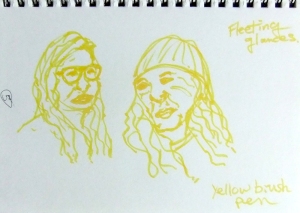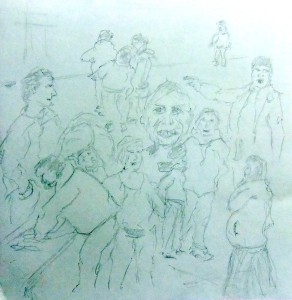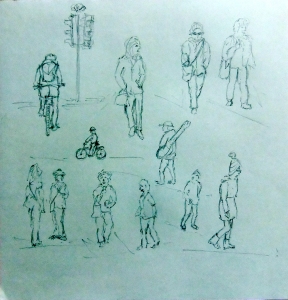Aim: Drawing moving figures or a changing scene can be extremely challenging. A large part of that challenge, however, is your own conception of the purpose. By taking a step back from trying to pin the action down to a static conclusion, and instead making a drawing which is a record of the movement and action itself, we can begin to reflect on how to balance movement and form to create a dynamic image.
Method: Find a fairly busy scene, with plenty of movement. Sit somewhere comfortable and out of the way and start making a drawing. As something catches your eye, capture it as best you can. Keep responding to movements as they happen so you build up a drawing full of dynamic energy. Depending on how fast you can capture form or how much repetition your view has, you may be able to build up a convincing representation of the scene. Whatever happens, you should be able to make a drawing which captures a sense of time elapsed, rather like a photographic long exposure. Don’t lose focus; make each mark as accurately as you can. Even if you just get a small mark representing the back of someone’s head before you lose them, make sure that mark is as accurately shaped and placed as you can get it.
Reflection: Review the work you’ve produced for this project and make some reflective notes in your learning log. What were the main challenges in working this way? Did you feel comfortable focusing on movement at the expense of a more ‘finished’ effect? Did you choose the right materials for the job? What would you do differently another time?
Process:
I began with some trial sketches to try and get myself used to the idea and feeling of sketching outside, on the street, in amongst people moving about. These are mainly random pickings from what came into my sight. However, sketches 3-5 are an attempt to start to try and create some kind of scene, or composition. In all I used biro-like pen, graphite pencil, pencil and brush pen:
A changing scene:
People coming and going at different stages of my viewing and sketching, and apart from the golum-like image in the centre, placed on the page to create an impression of a busy street scene.
A more separated and disjointed capturing of people about their business. I think I got a bit scared at this point as people were casting glances my way and I hurried and moved on.
A bit more relaxed now and building a more coherent scene made from individual cameo sketches.
Running out of steam a bit at this stage. Nonetheless, this pared-down sketch retains some semblance of perspective and sense of movement.
Reflection:
Is fear too strong a word? Out there and visible in the world of the street, uncomfortable and worried about what people might think. Please don’t approach me, as I do not want to tell you what I am doing and why. Get this over with quickly and let me get out of here.
These were my main reactions when out there. On reflection, I am pleased that I captured something of what I saw; pleased that I did manage to try out some different materials (sketchbook pages and drawing implements); and pleased that I did capture at least a sense of movement, moving on and not aiming for a ‘finished’ image.
If I want to become more confident with ‘urban sketching’ I certainly do need to push myself a lot more to open myself to the street-life experience. Living in a fairly rural environment I would need to plan ahead more as to where to sketch, materials to carry and time to allot.
Stuart Brownlee – 512319
6 January 2019









